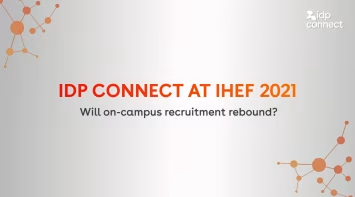An opinion blog by Robert Brannan
Over the years the use of data and evidence-based predictions have helped to indicate to the sector where the market may be going. As always though, predictions are never going to be 100% right and Clearing 2021 has shown this. To run a quick recap, many believed the circumstances were set up for this year's Clearing to be much bigger than it was the year before. You could argue that in some ways it was, when you look at the increased involvement of top-tier universities, the impact of COVID-19 on subjects like nursing, and the variety of strategies employed by universities. However, in terms of student numbers, it wasn’t.
It was predicted that we would see a cohort of students holding more negotiating power due to the continued use of teacher-based assessment. This set of circumstances was expected to provide students with the means to negotiate upwards and utilise Clearing as a vessel to achieve that. As it turns out, this was not entirely accurate. Although we saw the impact of teacher assessments with 44.8% of students receiving top grades, which resulted in an increased number of students being placed at top tier universities, we did not see the predicted increase in students using Clearing and Adjustment.
What we saw however, was a separate set of outcomes, two clear ones which impacted the viability of previous predictions. These were:
A 5% increase (c.20,000) YoY of students placed at their ‘Firm Choice’. No-one could have foreseen c.45% of students getting top results. These students clearly backed themselves though, and with that expectation, set their firm university choices. When all was said and done, they didn't need to use Clearing and Adjustment, they secured their final grades, cementing their place at their chosen institution.
The highest number of deferrals (c.31,000 students) we have seen over the past decade with 18-year-olds representing c.24,000 of those according to UCAS. This represented a 6% growth overall and a 13.4% increase amongst 18-year-olds.
Predictions, by their very definition, don’t always pan out the way you think they will, and sometimes this is for a reason that you did not even take into consideration in the first place. Donald Rumsfeld’s famous quote comes to mind here “...there are also unknown unknowns. There are things we don't know we don't know”.
Looking ahead to what is going to happen in 2021/22, well, quite frankly, it’s up in the air. There are so many variables that could impact the 2021/22 cycle that it could very much go in any path. What we can be sure of, however, are some of the factors we need to be aware of.
Deferrals
The build-up to Clearing 2021 and the event itself brought to light something many of us hadn’t foreseen, at least not in as dramatic a fashion compared to years past. In 2020, 133 universities were questioned and 35 responded that they had offered incentives if students chose them as their firm choice. Examples of this included promotions for financial incentives for students who achieved certain grades after making them a firm choice and tuition fee discounts alongside free flights, laptops etc. Overall, though, these incentives were never more than c.£1,000 - £2,000 in value per student.
This year however, the offers were slightly different. It is no longer about achieving set criteria (although these incentives we surely offered), but about attracting deferrals. Universities have begun offering incentives such as £10,000 alongside free accommodation to students who defer their place for a year. For one institution, they were oversubscribed with medical students, whilst their competition prioritised Law and Business students, indicating the situation varies case-by-case. The factor that remains is the implication this may have on the upcoming cycle.
Questions many institutions may be asking include: will these offers become more common place? If so, where do we draw the line? What is the impact going to be for universities that recruit primarily during Clearing if the top echelon of universities is quite literally able to have their cake and eat it too?
There are so many variables here to draw an outright conclusion as to what will happen in 2022, but the market suggests that:
1. We will likely see more incentives next year as we bounce back from the demographic dip and see more students applying to university, whether these offers are for deferring students, incentives to influence a change in choice, or both remains to be seen.
2. Deferrals may continue to rise, but potentially to a lesser extent depending on how the DfFE and Ofqual respond to “grade inflation”.
Teacher Assessment
It is fair to say that teacher assessments have had a huge impact on grades achieved by students both in 2020 and 2021 and therefore the institutions they have access to. In 2019, pre-COVID-19, only 8% of students achieved an A* grade, in 2020 this increased to 14.3% and in 2021 this rose to 19.1%.
If we then look a bit broader at A grades and above, we see that in 2021 a record 44.8% of students fell into this category compared to 25.5% back in 2019.
This increase has been beneficial for top-ranked universities and those students who have received better results. This has also increased accessibility to top tier universities for students from less privileged backgrounds applying to university, with 26.4% of 18-year-olds from this group being placed, the highest rate within the past 10 years. It has definitely put a squeeze however on mid / lower ranked universities who are less able to recruit these students.
The DfE (Department for Education) and Ofqual have made it clear their intention is to return to using exams in 2022. Whether that happens is yet to be seen because they are also making it clear that they are looking to set out contingency plans which would involve teacher assessment should exams not go ahead.
Whatever the outcome, the plan has been indicated to move away from teacher assessment. Their intention is to implement a staggered approach, with a positive being that this will not have an immediate impact on students for upcoming intakes. In contrast, the negative side to this is that the desire is to return to 2019 grade baseline and revert to similar levels of students achieving top results. This likely means those from disadvantaged backgrounds will be more affected and likely to see more challenges in gaining access to future higher education opportunities.
So, what does that mean for universities?
1. There will likely be increased competition during the main cycle and Clearing from high-ranking institutions until we see this “reversal” back to 2019 grade levels.
2. If exams do take place, institutions will potentially see more students going into Clearing in 2022, but should teacher assessments persist, universities who are more reliant on Clearing may find it a persistent challenge.
3. Should the latter take place, universities will need to be more pro-active during early engagement periods and the application deadline or lose out on potential students later in the year. Either way, the plan is a staggered return to the pre-Covid grade baseline which could mean that historically heavy Clearing recruiters may find the next few cycles more of a challenge.
As evidenced above, there is a continuation of many trends affecting the domestic market currently, with new ways of working and policy implementation. Discover more on Clearing 2021 as we deep-dive into our data looking ahead to the 2022 cycle in our latest webinar Dissecting Clearing 2021, register here.
Discover how we can support you during the Clearing period here.
You might like...

Increase in UK uni searches by international students despite Brexit
Data shows an increase in students looking to study in the UK following the vote to leave the European Union.

Emerging Futures Latest Research – Factors Affecting International Student Destination Choice
What drives first-choice destination decision making? How can institutions leverage these insights?

International Fees and Program Pricing
Is the cost of living combined with rising international fees driving students to other destination markets?



